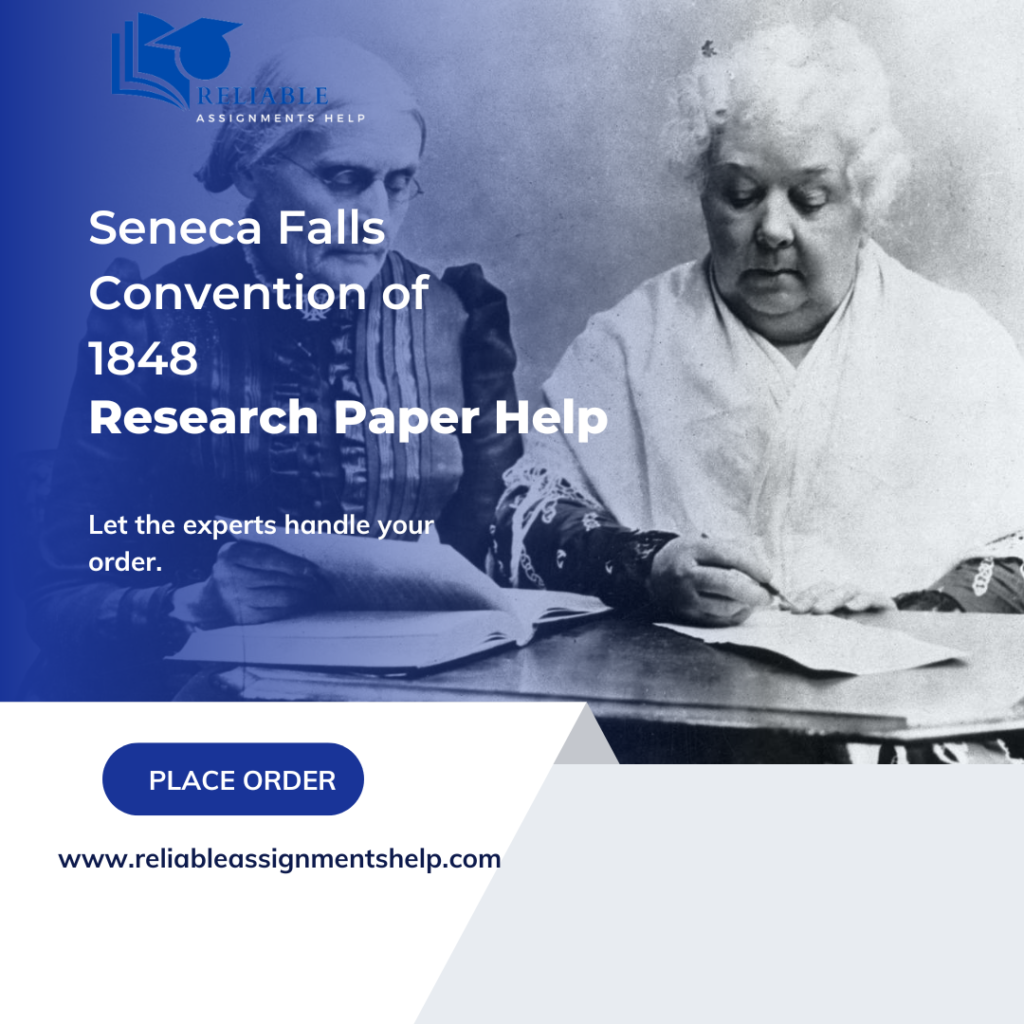Discussing the Seneca Falls Convention of 1848 and write 5-7 Pages on the topic. Please follow Chicago manual of style. Cover Page and Bibliography do NOT count in the page count.
Seneca Falls Convention of 1848 Research Paper Help- Research Guide
The Seneca Falls Convention of 1848 stands as a landmark event in the fight for women’s rights. Understanding its significance requires delving into the historical context, key figures, impactful documents, and lasting legacy. This guide equips you with the tools to navigate your research journey and craft a compelling exploration of this pivotal moment.
1. Setting the Stage: Historical Context
- Primary Sources: Newspapers and journals from the mid-19th century can offer valuable insights into societal attitudes towards women and the issue of slavery. Consider:
- The Liberator (abolitionist newspaper)
- The Seneca County Courier (local newspaper covering the convention)
- Secondary Sources: Explore books and articles that delve into the pre-convention social climate, including:
- “Women’s Suffrage in America” by Ann D. Gordon
- “Before Seneca Falls: Female Activists in the 19th-Century United States” by Judith Wellman
2. Meet the Changemakers: Key Figures
- Primary Sources: Personal letters, diaries, and speeches offer a glimpse into the minds and motivations of the convention’s key players. Resources include:
- The Elizabeth Cady Stanton and Susan B. Anthony Papers Project at Rutgers University (https://www.rutgers.edu/news/remembering-women-who-made-history-100-years-after-new-jersey-ratified-19th-amendment)
- The Frederick Douglass Papers at the Library of Congress (https://www.loc.gov/collections/frederick-douglass-papers/about-this-collection/)
- Secondary Sources: Biographies and analyses of key figures like Elizabeth Cady Stanton, Lucretia Mott, and Frederick Douglass can provide valuable context. Consider:
- “Elizabeth Cady Stanton and Susan B. Anthony: A Friendship That Changed the World” by Pamela McDougald
- “Lucretia Mott” by Norma Rae Smith
3. The Declaration of Sentiments: A Call to Action
- Primary Source: Analyze the Declaration of Sentiments itself, outlining its grievances and demands. You can find it online at the National Women’s History Museum website (https://www.nps.gov/wori/learn/historyculture/declaration-of-sentiments.htm).
- Secondary Sources: Explore scholarly articles and books that analyze the document’s historical significance and impact. Consider:
- “Seneca Falls and the Origins of the Woman’s Suffrage Movement” by Lois W. Banner
- “‘What the Fathers Gave Us’: Negotiating the Past in the Declaration of Sentiments” by Kathryn Kish Sklar
4. Examining the Legacy: Impact and Beyond
- Primary Sources: Look for newspaper articles and speeches following the convention to gauge its immediate impact and public reception.
- Secondary Sources: Explore books and articles that examine the long-term influence of Seneca Falls on the women’s rights movement and beyond. Consider:
- “The Woman’s Movement in the United States: From Abolition to Equality” by Ellen Carol Dubois
- “Seneca Falls and the Ongoing Struggle for Women’s Equality” by Stacy A. McLaughlin
Additional Resources:
- National Women’s History Museum: https://www.nps.gov/wori/
- Library of Congress Women’s History: https://guides.loc.gov/american-women
Research Tips
- Utilize online databases and library resources to access primary and secondary sources.
- Take detailed notes, including source citations, to ensure proper crediting.
- Analyze your sources critically, considering their biases and limitations.
- Develop a clear thesis statement to guide your research and writing.
By following this guide and diligently exploring the resources available, you can gain a comprehensive understanding of the Seneca Falls Convention and its lasting impact on the fight for women’s equality. Remember, effective research is an ongoing process, so keep exploring and uncovering the stories waiting to be told.

